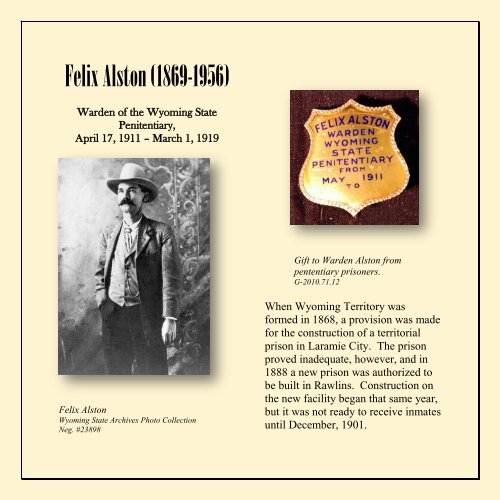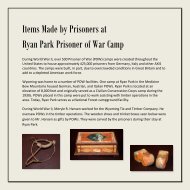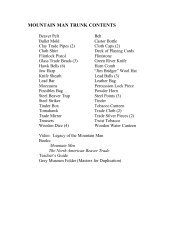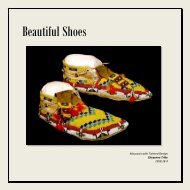Felix Alston (1869-1956) - the Wyoming State Museum
Felix Alston (1869-1956) - the Wyoming State Museum
Felix Alston (1869-1956) - the Wyoming State Museum
Create successful ePaper yourself
Turn your PDF publications into a flip-book with our unique Google optimized e-Paper software.
<strong>Felix</strong> <strong>Alston</strong> (<strong>1869</strong>-<strong>1956</strong>)<br />
Warden of <strong>the</strong> <strong>Wyoming</strong> <strong>State</strong><br />
Penitentiary,<br />
April 17, 1911 – March 1, 1919<br />
Gift to Warden <strong>Alston</strong> from<br />
pententiary prisoners.<br />
G-2010.71.12<br />
<strong>Felix</strong> <strong>Alston</strong><br />
<strong>Wyoming</strong> <strong>State</strong> Archives Photo Collection<br />
Neg. #23898<br />
When <strong>Wyoming</strong> Territory was<br />
formed in 1868, a provision was made<br />
for <strong>the</strong> construction of a territorial<br />
prison in Laramie City. The prison<br />
proved inadequate, however, and in<br />
1888 a new prison was authorized to<br />
be built in Rawlins. Construction on<br />
<strong>the</strong> new facility began that same year,<br />
but it was not ready to receive inmates<br />
until December, 1901.
Conditions in <strong>the</strong> new prison were<br />
less than ideal. There was little heat<br />
or plumbing. Initially, <strong>the</strong> facility<br />
was run by a contractor named Otto<br />
Gramm. Gramm, a wealthy merchant<br />
from Laramie City, was paid fifty<br />
seven cents per day per prisoner, and<br />
was entitled to <strong>the</strong> profits from <strong>the</strong><br />
prison’s broom factory,<br />
which was staffed by<br />
inmates. One inmate later<br />
wrote that, under Gramm’s<br />
administration, tomato cans<br />
were used for drinking cups,<br />
and meals were calculated<br />
down to <strong>the</strong> last bean so that<br />
just enough food was served<br />
to prevent starvation.<br />
By 1911, a number of guards<br />
had been murdered, several<br />
prisoners had been killed in escape<br />
attempts, and one had been hanged by<br />
o<strong>the</strong>r prisoners, making <strong>the</strong> prison <strong>the</strong><br />
focus of much conversation in <strong>the</strong><br />
state. Former senator Joseph M.<br />
Carey campaigned for governor<br />
promising an eight hour workday for<br />
women and children, good roads, use<br />
of <strong>the</strong> secret ballot, and <strong>the</strong> removal<br />
of Otto Gramm’s contract for<br />
operation of <strong>the</strong> state prison. Carey<br />
won <strong>the</strong> governor’s race and made<br />
Big Horn County Sheriff <strong>Felix</strong> <strong>Alston</strong><br />
<strong>the</strong> prison’s first state-appointed<br />
warden in April, 1911.<br />
<strong>Wyoming</strong> <strong>State</strong> Penitentiary, Rawlins<br />
<strong>Wyoming</strong> <strong>State</strong> Archives Photo Collection<br />
Neg. #13520<br />
The <strong>Wyoming</strong> Frontier Prison is now operated as a<br />
museum. For more information, please visit <strong>the</strong>ir<br />
website at: http://www.wyomingfrontierprison.org/
<strong>Felix</strong> <strong>Alston</strong> led an eventful life. At<br />
various times, he worked as a:<br />
cowboy on <strong>the</strong> Texas Trail; gold<br />
miner; election judge; feed store<br />
employee and owner; water and<br />
ice man; farmer; Yellowstone<br />
National Park guide; justice of <strong>the</strong><br />
peace; tax collector; deputy<br />
sheriff; and sheriff. He is most<br />
well-known for being <strong>the</strong><br />
investigator of <strong>Wyoming</strong>’s Spring<br />
Creek Raid, in which a number of<br />
cattle ranchers murdered three<br />
sheep ranchers.<br />
As warden, <strong>Alston</strong> brought a<br />
number of reforms to <strong>the</strong> prison.<br />
He brought books into <strong>the</strong> facility,<br />
provided educational opportunities,<br />
and added a physical fitness program<br />
for <strong>the</strong> inmates. <strong>Alston</strong> also believed<br />
that inmates should give back to <strong>the</strong><br />
community and ensured that crews of<br />
prisoners were kept busy making road<br />
repairs in <strong>the</strong> state. He is best<br />
remembered for creating a prison<br />
baseball team, which included two<br />
inmates he had previously arrested for<br />
arson and murder in <strong>the</strong> Spring Creek<br />
Raid. <strong>Alston</strong> served as warden of <strong>the</strong><br />
prison until March, 1919.<br />
<strong>Wyoming</strong> <strong>State</strong> Prison Baseball Team, 1911<br />
Warden <strong>Alston</strong>’s son, <strong>Felix</strong>, Jr. served as <strong>the</strong><br />
team’s bat boy.<br />
<strong>Wyoming</strong> <strong>State</strong> Archives Photo Collection<br />
Neg. # 9664<br />
<strong>Alston</strong> left <strong>Wyoming</strong> in 1920. He<br />
spent time in Texas and Mexico,<br />
finally settling for good in California,<br />
where he died in <strong>1956</strong>, at <strong>the</strong> age of<br />
86.
<strong>Wyoming</strong> <strong>State</strong> <strong>Museum</strong> Donation<br />
In 2010, <strong>Felix</strong> <strong>Alston</strong>’s grandson<br />
donated a large number of <strong>the</strong><br />
warden’s personal items to <strong>the</strong><br />
<strong>Wyoming</strong> <strong>State</strong> <strong>Museum</strong>. Included<br />
was this gold pocket watch, still in its<br />
original wooden presentation case,<br />
given to <strong>Alston</strong> on his first Christmas<br />
as warden. The inscription reads,<br />
“Presented to <strong>Felix</strong> <strong>Alston</strong>, Warden,<br />
by <strong>the</strong> Inmates of <strong>the</strong> <strong>Wyoming</strong> <strong>State</strong><br />
Penitentiary for his efforts on our<br />
behalf. December 25 th , 1911.”<br />
Howard railroad grade pocket watch in<br />
presentation case. Pocket watch engraved<br />
with “FA.”<br />
G-2010.71.1, 2<br />
The presentation was accompanied by<br />
a speech written on behalf of <strong>the</strong><br />
prisoners by Charles E. Bydenburgh,<br />
a Rawlins citizen. He was hired by<br />
inmates of <strong>the</strong> <strong>Wyoming</strong> <strong>State</strong><br />
Penitentiary to present <strong>the</strong> watch to<br />
<strong>Felix</strong> <strong>Alston</strong>. You can read <strong>the</strong><br />
speech here:<br />
https://sites.google.com/a/wyo.gov/alstonchristmas-speech/
Fake revolver completely carved from wood<br />
by an inmate and used in an unsuccessful<br />
escape attempt from <strong>the</strong> penitentiary.<br />
G-2010.71.14<br />
Horsehair belt made by an inmate at <strong>the</strong><br />
<strong>Wyoming</strong> <strong>State</strong> Penitentiary for Warden<br />
<strong>Alston</strong>'s son, <strong>Felix</strong>, Jr. It was ei<strong>the</strong>r made<br />
by Herbert Brink (one of <strong>the</strong> Spring Creek<br />
Raiders) or R.F. Morgan. Both were expert<br />
braiders and had made gifts for <strong>Felix</strong> Jr.<br />
G-2010.71.3<br />
Dice made by an inmate from stained<br />
wood and brass tacks.<br />
G-2010.71.11 a, b
Signature Stamp for <strong>Felix</strong> <strong>Alston</strong><br />
G-2010.94.27<br />
Convention Pin, American Prison<br />
Association Meeting, October, 1911<br />
G-2010.71.30
Big Horn County Sheriff<br />
<strong>Felix</strong> <strong>Alston</strong> served as <strong>the</strong> Under<br />
Sheriff and Sheriff of Big Horn<br />
County from 1903-1911, just before it<br />
was divided into smaller counties.<br />
Under Sheriff Badge, Big Horn County<br />
G-2010.71.16<br />
Sheriff Badge, Big Horn County<br />
G-2010.71.15
<strong>Alston</strong> earned a stellar reputation in<br />
law enforcement as <strong>the</strong> sheriff of<br />
Bighorn County. He oversaw range<br />
disputes between cattlemen and<br />
sheepherders and led <strong>the</strong> investigation<br />
to track down and arrest seven men<br />
responsible for murders in <strong>the</strong><br />
incident known as <strong>the</strong> Spring Creek<br />
Raid. In 1952, <strong>Felix</strong> <strong>Alston</strong> wrote a<br />
manuscript about his experiences<br />
from this time. Click here to read <strong>the</strong><br />
manuscript:<br />
https://sites.google.com/a/wyo.gov/<strong>the</strong>-springcreek-raid-by-felix-alston/<br />
Handcuffs<br />
G-2010.71.10<br />
Business Card<br />
G-2010.71.9 a-d
Personal Items<br />
<strong>Felix</strong> <strong>Alston</strong> was also a family man,<br />
avid fisherman, and member of<br />
several fraternal organizations. The<br />
artifacts donated to <strong>the</strong> <strong>Wyoming</strong><br />
<strong>State</strong> <strong>Museum</strong> show us this side<br />
of <strong>the</strong> man as well.<br />
<strong>Felix</strong> <strong>Alston</strong>’s Children (l to r):<br />
<strong>Felix</strong>, Jr., Eunice, Virginia (Peggy), and<br />
Helen Viola<br />
<strong>Wyoming</strong> <strong>State</strong> Archives Photo Collection<br />
P93-33/4<br />
<strong>Felix</strong> <strong>Alston</strong><br />
<strong>Wyoming</strong> <strong>State</strong> Archives Photo Collection<br />
P93-33/2
Watch fob with photos of Mrs. <strong>Alston</strong> and<br />
<strong>Felix</strong>, Jr.<br />
G-2010.94.40<br />
Meerschaum Pipe in Case<br />
G-2011.12.2 a, b, .3<br />
Last hat owned and worn by <strong>Felix</strong> <strong>Alston</strong>.<br />
G-2010.94.50
Mustache Cup<br />
G-2010.94.1<br />
Fishing Fly Box and Flies<br />
G2011.12.4 a,b; .17; .19<br />
G-2011.12.19<br />
<strong>Felix</strong> <strong>Alston</strong> With His Catch
Fraternal Organizations<br />
From <strong>the</strong> many artifacts donated<br />
relating to fraternal groups, <strong>Felix</strong><br />
<strong>Alston</strong> appears to have been a<br />
dedicated member of several<br />
volunteer service groups. These<br />
include <strong>the</strong> Benevolent and Protective<br />
Order of <strong>the</strong> Elks (BPOE); Modern<br />
Woodmen of America; Independent<br />
Order of Odd Fellows; Fraternal<br />
Order of Eagles; and Freemasons.<br />
BPOE<br />
<strong>State</strong> Convention Badge, Rawlins<br />
G-2010.71.27<br />
Elk Pin<br />
G-2010.94.36
Elk Antler Pin<br />
G-2010.71.26<br />
Golden Jubilee Grand Lodge Reunion, 1914<br />
G-2010.71.24<br />
Elks Tooth Cufflinks<br />
G-2010.94.46 a, b
O<strong>the</strong>r Fraternal Groups<br />
Fraternal Order of Eagles<br />
2011.12.21<br />
Modern Woodmen of America<br />
G-2010.71.17<br />
Independent Order of Odd Fellows<br />
G-2010.71.28
Freemasonry Cufflinks<br />
G-2010.94.30 a, b<br />
Scottish Rite of Freemasonry 32 nd<br />
Degree. Engraved: “Consistory,<br />
No. 1, Cheyenne, Wyo.,<br />
Gift of Dr. Barber Xmas 1918<br />
G-2010.94.38






